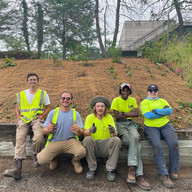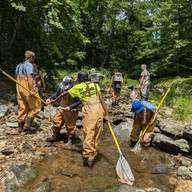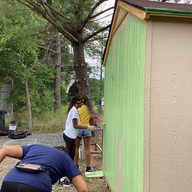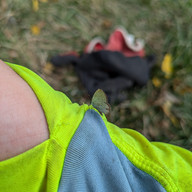Nurturing Landscapes & Career Building: July in Review
- Elura Morris

- Aug 30, 2024
- 6 min read
July was an exciting month of big projects for our team and memorable green industry training and exposure. Our team had a jam-packed schedule of gardening, tree planting, and career development. So let’s dive in!
Metrics

For the month of July, our team completed the following:
Visited 24 project sites.
Planted 47 native trees and shrubs.
Planted 759 native perennials, such as flowers and grasses.
Installed a total of 2,250 sq ft of conservation landscaping.
Coordinated 14 volunteers across 2 project sites
Projects
Mount Saint Joseph Conservation Landscape | Baltimore
Our organization completed the conservation garden at Mount Saint Joseph High School in July. This 1,748 sq ft landscape features 543 native perennials, and 37 native trees and shrubs. Special thanks to the National Fish and Wildlife Foundation for funding this project, the Interfaith Partners for the Chesapeake for partnering, and to the student volunteers who helped with installation.
Our journey began with removing the overgrowth of invasive plants, which was featured in our June Blog. We then conditioned the soil by tilling and amending with 10 cubic yards of a compost/biochar mix. The biochar was added with support of the Center for Watershed Protection’s Scaling Up Biochar applications across the Chesapeake Bay Project. We then laid down coir matting, and installed a silt fence prior to planting.
Overall this was a massive project that replaced invasive growth with beneficial native plants that provide habitats for pollinators. And it was a great learning experience for volunteer students and our young crew members.
Conservation Landscape | Ellicott City
Our teams installed a conservation landscape for a private resident in Ellicott City that was funded by the National Fish and Wildlife Foundation grant. This 500 sq ft project replaced grass with 7 native shrubs and 216 native perennial plants, enhancing stormwater management and creating a habitat for pollinators. If you’d like to learn how you can be a partner for a grant, check out our project opportunities page.
Ridgely Manor Park | Towson
We undertook a substantial meadow management project, covering 29,000 sq ft in Ridgely Manor Park, Towson, MD. Our crews focused on removing invasive species and vegetation and applying wood chips for weed suppression. This area is managed by NeighborSpace of Baltimore County, a non-profit that works with local communities to protect open spaces to improve stormwater treatment.
Professional Development and Green Industry Exposure
Our workforce development programs UpLift, READY, & EcoAmbassadors offer opportunities for growth in career development through exposure, networking, and training. Here’s what they did in July:
Poplar Island Tour
Uplift and READY had an exciting time visiting Poplar Island with Maryland Environmental Service. This active restoration site in the Chesapeake Bay is transforming thanks to soil dredged from the bay to create wetlands and habitats. Originally 1100 acres, the island eroded to just 4 acres before restoration efforts began in the year 2000.
Our team spent the day learning about construction, conservation projects, and job opportunities with Maryland Environmental Service. Highlights included spotting diverse bird species, learning about terrapin turtle conservation efforts on the island, and even holding baby terrapins! This year, a record-breaking 360 terrapin nests were found—exciting news for conservation!
This opportunity was made possible by the Climate Crew Network, Emily Morrow from the Maryland Department of Natural Resources, and the Greater Baltimore Wilderness Coalition with support from Howard County Government.
Little Patuxent Tour
Uplift and READY had the opportunity to tour the Little Patuxent Water Reclamation Plant with plant manager, Robert Hindt. Robert gave an informative presentation on the science of sewage treatment and the methods used at the plant. He also provided an overview of the various career opportunities in the sewage and water treatment industry. Key highlights included the plant’s commitment to sustainability: biogas produced during one treatment process is captured and reused to power the plant. Additionally, the plant converts waste into valuable resources: clean water, which is returned to the environment, and agriculture-safe fertilizer, which is used on active farms.
Electrofishing
Throughout July our Senior crew, UpLift, and READY crews were divided into teams to go electrofishing throughout Montgomery Parks. They each met up with Aquatic Biologist Dave Sigrist at three separate locations to assist researchers in collecting aquatic species.
What is electrofishing? It is the process of using electric currents to temporarily stun aquatic species swimming downstream. Once stunned, the animals are safely captured, and data is collected before they are released back into the stream. This data helps Montgomery County assess the health of the stream, the wildlife, and the overall condition of the watershed.
Employer Panel
We hosted an Employer Panel and Mock Interview Day, facilitated by Matt Hemler and Emily Morrow. The day began with our Uplift and READY crews practicing their interviewing skills and elevator pitches. Afterward, the high school EcoAmbassadors joined the crew for a talk by Bill Mahoney, Sustainability Project Manager from the Office of Community Sustainability, about Howard County's green infrastructure network.
In the afternoon, 12 guests from various green industry organizations shared insights about their organizations and conducted mock interviews with our crews. The event concluded with a networking session, allowing the crew and employers to connect and exchange valuable advice and feedback. Overall, it was a highly productive day focused on learning and career development.
Special thanks to Emily Morrow (Maryland DNR), Brendon Brown (TreeBaltimore, BCRP), Danielle Fisher (MD Port Administration), Diane Knighton (Design with Nature), Eric Ettenhofer (Lerch Brother LLC), Matias Orrego (MES), Tony Faoro (Davey Trees), Marty Adams and Scott Anderson (Bartlett Tree Experts), Michael Augustin (Chesapeake Conservancy), Jonathan McKinney (CEI), and EcoWorks staff for their contributions and support.
Professional Training | READY & UPLIFT
Career Development: Our Project Coordinator, Matt Hemler, led a number of trainings focused on team building, professional skills, job searching, and career development.
Financial Literacy: Financial Educator and Coach Durshawn Robinson, visited us and provided important knowledge about financial literacy.
CBLP-A: Our crews had two learning days to train for the Chesapeake Bay Landscape Professional - Associate certificate.
Native Plant ID Training: Our crews learned native plant ID at the First Presbyterian Church, where one of the rain gardens we regularly maintain is located. This training involved sketching native plants and identifying their key characteristics.
Watershed Science Training: Our crews received training on watershed science and assessments from our Executive Director, Lori Lilly.
Professional Training | EcoAmbassadors
Jackie Cooper Visit: Jackie Cooper from The Office of Community Sustainability at the Howard County Government, shared insights about the Howard County Climate Action Plan which included initiatives such as: electrifying the county vehicle fleet, aiming for net zero emissions by 2040, expanding the tree canopy, and enhancing pollinators habitat.
Amy Handen Visit: Amy Handen, Local Implementation Programs Coordinator for the EPA and the Chesapeake Bay Program, talked about the principles of behavior change, and how to convince communities to adopt healthier, and sustainable practices.
Bill Mahoney Visit: Bill Mahoney from the Howard County Office of Community and Sustainability, shared information about the Green Infrastructure Network. The network consists of the highest-priority habitat corridors and ecological areas that the county is trying to restore and preserve.
Marketing Training: Elura Morris, Marketing & Communications at EcoWorks, gave a training on marketing skills and techniques that can be used for outreach and projects.
Milestones, Media, and Merits
Volunteering
Mount St Joseph: We had 10 high school students volunteer for the MSJ project mentioned above.
Nursery Shed Painting: We had 4 volunteers, including 3 from Girl Scout Troop #1250, who helped paint our new shed at Seeds of Change Nursery. Additional thanks to Elura Morris and Zsuzsanna Cooke for helping us coordinate our volunteers.
Outreach
Good Kidizen Event: EcoAmbassadors tabled for EcoWorks at the Good Kidizen/City in the Garden Guardians event at Color Burst Park in Columbia. They took this opportunity to engage with families and spread eco-awareness.
Savage Farmers’ Market: At the Savage Farmer’s Market, our Marketing and Outreach Coordinator Elura Morris represented EcoWorks with a captivating display. We showcased native plants for sale while seizing the opportunity to engage the community in discussions of environmental sustainability and restoration.
Publication
Our sustainability intern, Jazlyn Benitez, created these pdfs on Biochar and Beaver Dam Analogs that are available on our knowledge center page.

EcoWorks Anniversary!
July marks 7 years of Howard EcoWorks! Our organization began operations in the summer of 2017, its origins spanning back to 2012 with the development of the READY program. The heart and mission of EcoWorks have stayed the same over the years, but we certainly have grown a lot!
We've gone from only running short seasonal crews to now having multiple seasonal crews and a year-round senior crew. We've also expanded staff positions over the years. We built a native plant nursery at the Corrections Facility in Howard County. And our eyes are set on potential new pastures and growth for our organization.
We've made a tremendous impact on our local region, communities, and watersheds with tree plantings, pollinator gardens, and rain gardens. And we couldn't have done it without the support of our community, past and present Board Members, Howard County Government, Chesapeake Bay Trust, many other grantors, local schools, churches, residential communities, and more. So thank you for a blessed 7 years.
CONCLUSION:
As July wraps up, we're proud of the progress made in both our projects and programs. With each tree planted and skill gained, we’re shaping a greener future together. Here's to more growth in the months ahead!
Enjoy these photos from our crew!































































































































































































































































































































Comments